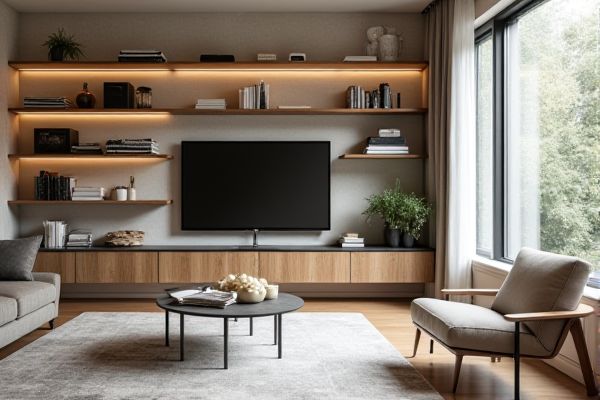
Freestanding shelves offer flexibility and easy relocation, perfect for renters or those who frequently change room layouts, while built-in shelves provide a seamless, custom look that maximizes space and adds long-term value to your home. Explore the rest of the article to determine which shelving solution best fits Your needs and lifestyle.
Table of Comparison
| Feature | Freestanding Shelves | Built-in Shelves |
|---|---|---|
| Installation | Easy to assemble and move, no permanent changes. | Requires professional installation, permanent fixture. |
| Customization | Limited size and design options. | Highly customizable to fit space and style. |
| Durability | Less sturdy, prone to tipping or damage. | More durable and stable, integrated with wall structure. |
| Cost | Generally more affordable upfront. | Higher initial cost due to materials and labor. |
| Space Efficiency | Takes up floor space, less efficient use of room. | Maximizes space by utilizing wall cavities. |
| Mobility | Portable, can be relocated easily. | Fixed, cannot be moved once installed. |
Introduction to Freestanding and Built-In Shelves
Freestanding shelves offer versatile storage solutions that can be easily moved and rearranged, making them ideal for dynamic living spaces or rental properties. Built-in shelves provide a permanent, custom-fit option that maximizes space utilization and enhances architectural aesthetics, often increasing property value. Choosing between the two depends on factors such as room layout, design preferences, and long-term functionality needs.
Design Flexibility: Comparing Freestanding and Built-In Options
Freestanding shelves offer unmatched design flexibility, allowing you to easily rearrange or replace units to suit changing spaces and styles. Built-in shelves provide a customized, seamless look that maximizes wall space and integrates with your home's architecture but lack the mobility of freestanding options. Choosing between these depends on whether you prioritize adaptability or a permanent, tailored aesthetic.
Space Efficiency: Maximizing Room with Shelving Choices
Freestanding shelves offer flexible placement options that can be easily rearranged to optimize your room's layout, while built-in shelves maximize vertical space by utilizing wall cavities, creating a seamless and tailored storage solution. Built-in shelves often provide greater space efficiency in small or irregular rooms by eliminating gaps between shelving and walls, whereas freestanding shelves may consume more floor space but allow for mobility and adaptability. Choosing the right shelving type depends on your specific spatial needs and preferences for either permanent integration or versatile storage.
Installation Process: Ease and Complexity
Freestanding shelves offer a straightforward installation process, requiring minimal tools and allowing immediate use without structural modifications. Built-in shelves demand precise measurements, anchoring to wall studs, and possibly professional carpentry skills, making installation more complex and time-consuming. Choosing between the two depends on the desired permanence, room aesthetics, and willingness to invest in installation effort.
Cost Comparison: Initial Investment and Long-Term Value
Freestanding shelves generally have a lower initial investment cost compared to built-in shelves, making them a budget-friendly option for immediate storage needs. Built-in shelves, while more expensive upfront due to customization and installation, offer greater long-term value by increasing home resale value and providing durable, space-efficient storage. Understanding Your needs and budget helps determine if the cost difference aligns with the expected benefits of either option.
Mobility and Adaptability: Adjusting to Changing Needs
Freestanding shelves offer superior mobility and adaptability, allowing easy relocation and reconfiguration to meet evolving storage needs without structural modifications. Built-in shelves provide a permanent, custom-fit solution but lack flexibility, requiring professional alteration for adjustments or relocation. Choosing between them depends on the necessity for dynamic space management versus long-term, stable storage integration.
Durability and Maintenance: Longevity of Shelving Types
Built-in shelves generally offer superior durability due to their fixed installation and use of robust materials like solid wood or plywood, ensuring long-term stability. Freestanding shelves, while versatile and easy to move, often employ lighter materials such as MDF or particleboard, which may be more prone to wear and require frequent maintenance. Maintenance for built-in shelves is minimal once installed, whereas freestanding units might need periodic tightening of screws and more careful handling to sustain longevity.
Aesthetic Impact: Enhancing Home Interiors
Freestanding shelves offer versatile placement and style adaptability, allowing homeowners to easily update their interior aesthetics with varying designs and materials. Built-in shelves create a seamless, integrated look that enhances architectural details and maximizes space efficiency, contributing to a polished and cohesive home interior. Selecting between these options depends on desired visual continuity and the level of customization within the living space.
Customization Potential: Tailoring Shelves to Your Style
Freestanding shelves offer flexible customization with easy rearrangement and style changes to suit evolving decor preferences. Built-in shelves provide a tailored, permanent solution that can be designed to fit specific dimensions and architectural features of your space. Choosing between them depends on whether you prioritize adaptable design or seamless integration with your interior style.
Which Shelving Solution is Right for You?
Freestanding shelves offer flexibility and easy relocation, making them ideal for renters or those who frequently change room layouts, while built-in shelves provide a permanent, custom fit that maximizes space and adds value to your home. Consider the budget and long-term goals, as built-ins typically require professional installation and higher investment compared to the affordability and DIY nature of freestanding options. Your choice should align with your need for adaptability versus a sleek, integrated appearance that complements your interior design.
 homyna.com
homyna.com